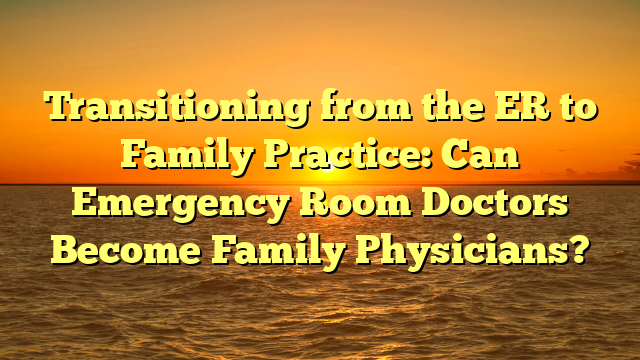Transitioning from the ER to Family Practice: Can Emergency Room Doctors Become Family Physicians?
Introduction
Transitioning from one medical specialty to another can be a challenging and complex process. In this article, we will explore the possibility of emergency room doctors making the transition to family practice. We will discuss the similarities and differences between these two specialties, the necessary steps for transitioning, and the potential benefits and challenges that emergency room doctors may face in becoming family physicians.
Similarities and Differences between Emergency Room and Family Practice
While emergency room doctors and family physicians both work in the field of medicine, there are significant differences in their roles and responsibilities. Emergency room doctors are trained to handle acute and life-threatening conditions, often in high-stress and fast-paced environments. They must make quick decisions and provide immediate care to patients in critical condition.
On the other hand, family physicians focus on providing comprehensive and continuous care to individuals and families of all ages. They manage chronic conditions, provide preventive care, and develop long-term relationships with their patients. Family physicians often work in outpatient settings and have a more holistic approach to healthcare.
Despite these differences, there are also several similarities between emergency room and family practice. Both specialties require strong clinical skills, the ability to communicate effectively with patients, and the capacity to work well under pressure. Additionally, both emergency room doctors and family physicians must stay up-to-date with the latest medical research and advancements in their respective fields.
Steps for Transitioning from the ER to Family Practice
Transitioning from the emergency room to family practice requires careful planning and preparation. Here are the steps that emergency room doctors can take to make a successful transition:
- Evaluate your interest and motivation: Before making the transition, it is important to assess your interest in family practice and your motivation for pursuing this career change. Reflect on your reasons for wanting to become a family physician and consider how your skills and experiences align with the requirements of the specialty.
- Research the requirements: Familiarize yourself with the educational and licensing requirements for family practice. Depending on your current qualifications, you may need to complete additional training or obtain specific certifications to practice as a family physician.
- Seek additional training: If necessary, pursue additional training in family medicine. This may involve completing a residency program in family practice or participating in specialized courses or workshops to enhance your knowledge and skills in this area.
- Network with family physicians: Connect with family physicians in your area and seek mentorship opportunities. Building relationships with experienced family physicians can provide valuable insights and guidance as you navigate the transition process.
- Update your resume and credentials: Update your resume to highlight relevant experiences and skills that are transferable to family practice. Ensure that your credentials, such as medical licenses and certifications, are up-to-date and in line with the requirements of family medicine.
- Apply for family practice positions: Start applying for family practice positions once you feel confident in your readiness to make the transition. Tailor your application materials to showcase your commitment to family medicine and your ability to provide comprehensive care to patients.
Benefits and Challenges of Transitioning
Transitioning from the emergency room to family practice can offer several benefits for doctors seeking a change in their medical career:
- Opportunity for long-term patient relationships: Family physicians have the opportunity to develop long-term relationships with their patients, providing continuity of care and the ability to make a lasting impact on their health and well-being.
- Expanded scope of practice: Family physicians have a broad scope of practice, allowing them to diagnose and treat a wide range of conditions across different age groups. This can provide a sense of professional fulfillment and intellectual stimulation.
- Work-life balance: Family practice often offers more regular working hours and a better work-life balance compared to the high-stress and unpredictable nature of emergency room work.
However, transitioning from the emergency room to family practice also comes with its own set of challenges:
- Adapting to a different pace: Family practice typically involves a slower pace compared to the fast-paced environment of the emergency room. Some doctors may find it challenging to adjust to the change in workflow and patient volume.
- Building a new patient base: Starting a new practice or joining an existing family practice requires building a new patient base. This can take time and effort to establish a steady stream of patients.
- Continuing education: Family physicians must stay updated with the latest research and guidelines in various areas of medicine. This requires a commitment to lifelong learning and professional development.
Conclusion
Transitioning from the emergency room to family practice is a significant career change that requires careful consideration and planning. While there are similarities between these two specialties, there are also notable differences in their roles and responsibilities. By following the necessary steps and being aware of the potential benefits and challenges, emergency room doctors can successfully make the transition to family practice and embark on a rewarding career in primary care.











